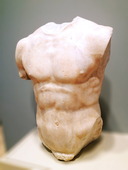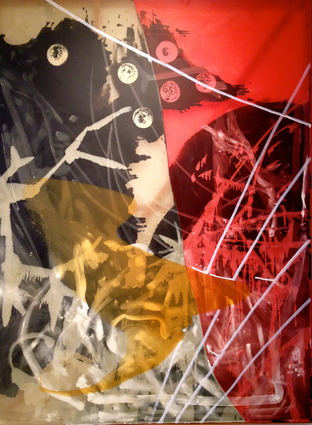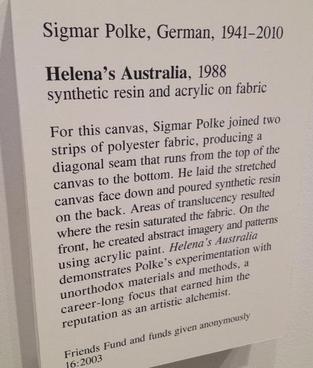Self in the Abstract Sun, 1st December, 2013
This Thanksgiving weekend afforded the opportunity to spend time with my family wandering the new wing of the St. Louis Museum of Art. There I discovered some wonderful abstract and other forms of "modern" art that spoke to me in a way I had never fully appreciated before.
We started our exploration of the new wing by walking through some ancient art, including the classical sculpture of the male torso to the right. Then we stepped into a world of colorful abstraction, where the artist and the expression of ideas are front and center, in direct contrast to the classical approach that seems to have largely removed the artist from the equation. The classic artist, such as the one who chiseled this torso, may have presented an idealized version of reality but the result is still concrete and literal, following the forms that everyone expects. People may differ slightly in their interpretation of the torso—perhaps it's a man, perhaps it's a god, perhaps it's too idealistic, etc.—but everyone agrees that it's a male torso.
The abstract art is all about interpretation and not being bound by traditional forms. It's about an idea, or a technique or even an experiment, but in this way it's all about what's in the mind of the artist, not what's in the mind of the viewer. When one looks at it, it may say all kinds of contradictory things at once, requiring you to retrace the thought process of the artist to even begin making sense of it. Even so, it will ultimately mean something completely different to each person who experiences it, requiring you to add something of yourself before you can be fully satisfied.
And so it is with my own personal spirituality and liberal religion in general. Though we take inspiration from, and find beauty in, the classical forms of theology and worship, I find them too confining, too literal. There's not enough room in them for personal exploration and self-expression. What's the point of creating an exact replica of reality when there's a whole universe of ideas to explore. The point is we experience these ideas together as a religious community but we all take a little something different from the experience.
Click on the abstract image to the right to enjoy more images from SLAM.
This Thanksgiving weekend afforded the opportunity to spend time with my family wandering the new wing of the St. Louis Museum of Art. There I discovered some wonderful abstract and other forms of "modern" art that spoke to me in a way I had never fully appreciated before.
We started our exploration of the new wing by walking through some ancient art, including the classical sculpture of the male torso to the right. Then we stepped into a world of colorful abstraction, where the artist and the expression of ideas are front and center, in direct contrast to the classical approach that seems to have largely removed the artist from the equation. The classic artist, such as the one who chiseled this torso, may have presented an idealized version of reality but the result is still concrete and literal, following the forms that everyone expects. People may differ slightly in their interpretation of the torso—perhaps it's a man, perhaps it's a god, perhaps it's too idealistic, etc.—but everyone agrees that it's a male torso.
The abstract art is all about interpretation and not being bound by traditional forms. It's about an idea, or a technique or even an experiment, but in this way it's all about what's in the mind of the artist, not what's in the mind of the viewer. When one looks at it, it may say all kinds of contradictory things at once, requiring you to retrace the thought process of the artist to even begin making sense of it. Even so, it will ultimately mean something completely different to each person who experiences it, requiring you to add something of yourself before you can be fully satisfied.
And so it is with my own personal spirituality and liberal religion in general. Though we take inspiration from, and find beauty in, the classical forms of theology and worship, I find them too confining, too literal. There's not enough room in them for personal exploration and self-expression. What's the point of creating an exact replica of reality when there's a whole universe of ideas to explore. The point is we experience these ideas together as a religious community but we all take a little something different from the experience.
Click on the abstract image to the right to enjoy more images from SLAM.


